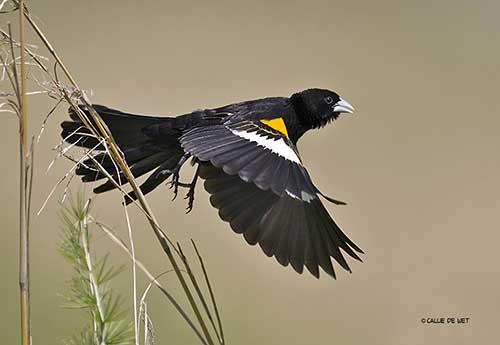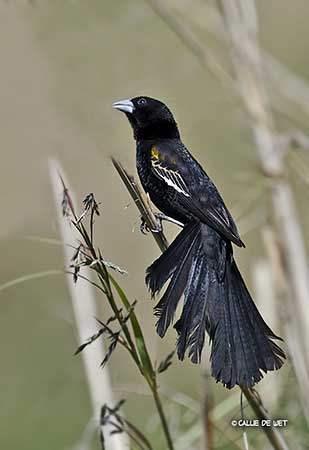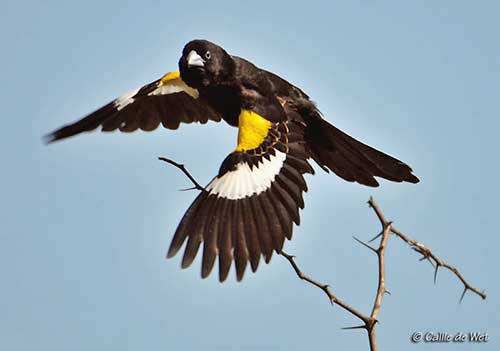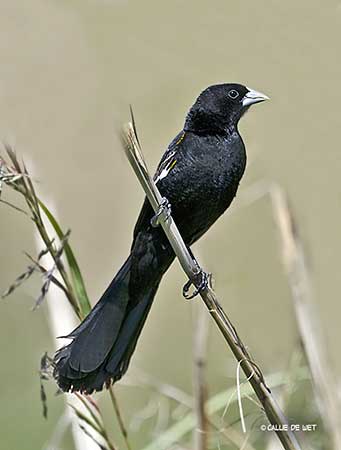
Fr: Euplecte à épaules blanches
Ang: White-winged Widowbird
All: Spiegelweber
Esp: Obispo Aliblanco
Ita: Vedova alibianche
Nd: Spiegelwidavink
Sd: vitvingad vidafink
Photographer:
Callie de Wet
GALLERY
Text by Nicole Bouglouan
Sources :
HANDBOOK OF THE BIRDS OF THE WORLD Vol 15 by Josep del Hoyo-Andrew Elliot-David Christie - Lynx Edicions – ISBN: 9788496553682
BIRDS OF AFRICA SOUTH OF THE SAHARA by Ian Sinclair and Peter Ryan - Princeton University Press Princeton and Oxford - ISBN: 0691118159
ROBERTS BIRDS OF SOUTH AFRICA by G. R. Mc Lachlan and R. Liversidge – The Trustees of the John Voelcker Bird Book Fund – ISBN: 0620031182
Roberts Online – Birds of Southern Africa
Biodiversity Explorer – The Web of Life in Southern Africa
theguardian - Mystery bird: white-winged widowbird, Euplectes albonotatus
White-winged Widowbird
Euplectes albonotatus
Passeriformes Order – Ploceidae Family
INTRODUCTION:
The White-winged Widowbird is currently included in the subfamily Ploceinae within the large family Plodeidae (weavers).
This species is relatively common throughout most of the range in sub-Saharan Africa, and mainly in E, SE and South Africa. It frequents moist or marshy areas and tall grassland where it feeds on seeds of grasses and insects. It is gregarious outside breeding season and may form large flocks at communal roosts. It is resident in its range.
The White-winged Widowbird has currently stable population and the species is not globally threatened.
DESCRIPTION OF THE BIRD:
Biometrics:
Length: 14 cm (tail: 8-8,5 cm)
Weight: M: 20-27 g – F: 16-24 g
The White-winged Widowbird adult male in breeding plumage has black plumage overall including the head. However, on the upperwing, the black primaries have white bases, whereas the secondaries show white bases and narrow buff edges. The lesser coverts are bright yellow and the black median coverts have buffy edges. The black tertials and also primary and greater coverts show broad white edges. This pattern forms a white wing patch conspicuous in flight, with a white and yellow epaulet on shoulder. The fairly long, fan-shaped tail is black.
On the underparts, the underwing coverts are white.
The bill is blue-grey. The eyes are dark brown. Legs and feet are dark grey.

The non-breeding male has mostly brown upperparts with dark central streaks to feathers. The shorter tail is dark brown, but all rectrices show paler edges.
On the underparts, chin and throat are whitish. Breast and flanks are buffy-white, slightly streaked on flanks and breast sides. Belly and undertail coverts are whitish.
On the head, we can see a broad, whitish supercilium. The ear-coverts are buffy-brown, and there is a dark stripe behind the eye. The bill is blue-black.
The adult female resembles non-breeding male but she has brown wings. The lesser coverts are brown with yellow fringes. The underparts are whiter, less buffy than in male.
The bill is brown, like legs and feet.
The juvenile resembles female, with some yellow wash on the upperparts.
SUBSPECIES AND RANGE:
The White-winged Widowbird has three subspecies.
E.a. eques occurs in Central African Republic, W and S Sudan, S and E Ethiopia, W Rwanda, W Burundi, S Uganda and Kenya, S to S Tanzania.
In this race, the breeding male has cinnamon-brown epaulets (not yellow), whereas the female has cinnamon edges to lesser wing-coverts.
E.a. asymmetrurus is found in São Tomé, W Gabon, PRCongo, W DRCongo and Angola.
In this race, the breeding male has much longer tail (13 cm).
E.a. albonotatus (described above) is found in S Tanzania, SE DRCongo, Zambia, Malawi, NE Namibia, N and E Botswana, Zimbabwe, S Mozambique, Swaziland and E South Africa.
HABITAT:
The White-winged Widowbird prefers habitats with rank vegetation and water such as moist grassland and marshy areas. It also frequents roadsides with tall grasses, and overgrown areas at edges of cultivated land.
CALLS AND SONGS: SOUNDS BY XENO-CANTO
The White-winged Widowbird is rather quiet. It utters a rustling sound followed by throaty double chirp “zeh-zeh-zeh” and “squee-squee-squeege-squeege” given both from perch and in flight.

BEHAVIOUR IN THE WILD:
The White-winged Widowbird feeds primarily on seeds of grasses of several species. It also drinks the nectar of Mountain aloe (Aloe marlothii). It may occasionally hawk termites alates in flight, but it returns to a perch to eat them.
It feeds mainly on the ground and among vegetation, usually in small groups.
The White-winged Widowbird is polygynous, territorial and solitary nester. A single male usually mates with up to four females during the breeding season. The territory is defended against other males, but also other widowbirds and bishops including the Southern Red Bishop.
During the displays, the male sings from high perch. It adopts an erect posture with the nape feathers ruffled and the tail fanned and lowered. It also performs a flight display during which the tail is spread. It flies with exaggerated wingbeats to enhance the bright colours of the epaulets.
When a female lands in the territory, the male comes to the ground, usually among grasses, and starts displaying with hunched wings and fanned tail. It bounces up and down while calling.
It may also display at nest always while singing. It hangs from the entrance with quivering wings. When the female is ready for copulation, she raises her wings, the tail is quivering and she gives piping calls.
The White-winged Widowbird is resident in its range, and only moves locally during the dry season.
The flight is strong and powerful.

REPRODUCTION OF THIS SPECIES:
The breeding season varies according to the range, but the main laying period takes place between December and February/March.
The White-winged Widowbird male builds several nest frames, at least two, about 10-25 metres apart. The nest is oval with a large side-top entrance. It is supported by vertical grass stems woven into the roof. It waves a framework of both dry and semi-green grass.
The female takes part in nest-building and brings finer dry grass to make a thick, woven layer used as lining, which may project as a porch. This structure is placed between 0,30 and 1,50 metre above the ground, in dense grass.
The female lays 2-4 pale greenish-blue eggs with olive-green speckles. She incubates alone during 12-15 days. At hatching, the chicks are naked with pink skin. They are fed first by regurgitation by the female. They leave the nest 11-14 days after hatching, and are independent 22-25 days later.
Eggs and chicks are eaten by mice, and the nests are destroyed by predators, including humans. Some nests are parasitized by the Diederik Cuckoo.
PROTECTION / THREATS / STATUS:
The White-winged Widowbird is relatively common in most of the range and São Tomé, but less common in NW of the range. The species is widespread in cultivated land and disturbed habitats, and also occurs in protected areas.
The population is suspected to be stable, and currently, the White-winged Widowbird is evaluated as Least Concern.
